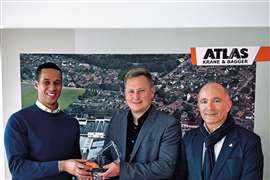Zero emissions for trucks and vans: How Vanair launched its EPEQ battery powered range
06 December 2021
Vanair introduces the EPEQ group of battery-powered equipment, Chad Elmore reports
Through the launch of its new EPEQ product group, Vanair has added battery power to its existing catalog of Mobile Power Solutions. The company’s engineering team developed the EPEQ Electrified Power Equipment product line as a zero-emission power source for work trucks and vans. Powered by Vanair’s new ELiMENT lithium iron phosphate battery, the system allows operators to turn off the vehicle’s engine and still run the equipment needed to complete a job. The system is self-contained and can be mounted on or within engine-powered or battery-powered vehicles, as well as trailers.
 Vanair developed its new EPEQ line of battery-powered equipment in part due to the growing trend of using van bodies for service trucks.
Vanair developed its new EPEQ line of battery-powered equipment in part due to the growing trend of using van bodies for service trucks.
The creation of the product group was driven in part by a growing interest in battery-powered vehicles, as well as the trend toward creating service vehicles from vans that do not have a power take-off (PTO). Typically, a van application would use one of the company’s Air N Arc All-In-One power systems.
“Vanair has always had engine-driven components – and it’s still a large part of our product offering,” said Chip Jones, strategic accounts manager, Vanair, Michigan City, Ind., “but the growth in electric vehicles has created a need for clean and quiet power. Many of our customers are also using vans for service trucks. We can safely mount an engine-based unit in a van, but it’s loud and produces heat. That application is where the real need for our electrified power solution came from. By using an EPEQ system in a van body, we’ve seen about a 60% decrease in noise versus the competitive engine-driven unit. The technology is really getting to a point where we can get the full potential out of these batteries, as well. In the past it would have been tricky to create this lineup – and it would have been very cost prohibitive. The technology of lithium cells has really caught up in the past couple of years.”
EPEQ product line
Each product in the EPEQ line is designed and optimized to work within a battery-powered system. The company said its engineers used electric motors that were designed to operate more efficiently than standard motors, to help extend the life of the battery. The lithium iron phosphate batteries were developed by Vanair with a battery management system (BMS) that can discharge power while being charged back simultaneously. The Smart Control I/O board uses proprietary software technology designed to intelligently monitor and control each component in the EPEQ system. It also communicates with the host vehicle’s system. Each component can communicate signals to and from the board to allow battery power to be adjusted based on factors such as: temperature, heat build-up, duty cycle, assigned function priorities, and power remaining.
“Vanair’s bread-and-butter has always been our PTO-driven underdeck systems,” said Jones. “Using a single PTO opening and the truck’s own engine for power, these systems provide impressive air power, ac power, hydraulics or any combination of all three. Of course, we’ll still meet the needs for our traditional product lines, along with EPEQ as a new product category for us. EPEQ is not replacing anything – it will just be another option for our customers.”
Which alterantive markets?
The company said EPEQ was designed as an alternative for markets that include on-highway fleets, road construction equipment, mining, fire and rescue, marine, recreation, cranes, and light commercial service vehicles.
In addition to the ELiMENT battery itself, the line of proprietary products include: electric motor-driven air compressors for 20 to 45 cfm at 150 psi, ac power inverters, electric vehicle charging, welding, hydraulic power, electric-driven underdeck component systems and abovedeck modular units for up to 160 cfm at 150 psi, and dc-dc converters. Depending on the power form that a customer needs, the company said a single-function machine can be ordered or an entire EPEQ ecosystem which combines all products required for a specific application.
 The ELiMENT battery.
The ELiMENT battery.
The EPEQ EV Charger can give service technicians the ability to charge electric vehicles when away from a permanent mount charging unit. The modular design of the EPEQ product line allows the customer to add Level 2 electric vehicle charging capabilities to an EPEQ air compressor system. The EV Charger can be a stand-alone component, or it can be added to another EPEQ product.
“With the ability to charge electric vehicles from these components, EPEQ also ties into our Goodall product lineup of engine charging and jump-starting equipment,” said Jones. “Some of the components from the EPEQ business, such as the electric vehicle charging system, will also be offered as a module for our all-in-one engine-driven compressors. We’ll be able to add on some modules for our other products, as well.”
The company typically sells its system through dealers and commercial body upfitters and said EPEQ will be handled through the same channels when it becomes available in 2022.
“We will offer a complete kit similar to what we do now with our engine and PTO-driven units,” said Jones. “We’ve always been good at offering our dealers a turnkey package. When they order an underdeck system, it can be a little overwhelming if they had to spec’ each component, so we supply everything in one kit. We’ll do that on the EPEQ side, as well. We’ll have some complete kits that we’ll offer, and its modular design means customers can easily add or remove components.
“If we have a customer who does service work and who wants an air compressor and an AC power inverter, they can have that. Then, a year or two down the road when they realize they’re starting to see more electric vehicles in the area, they can easily add the charging module.”
 The EPEQ AIR20 is a reciprocating compressor designed for intermittent air use. It puts out 20 cfm @ 150 psi.
The EPEQ AIR20 is a reciprocating compressor designed for intermittent air use. It puts out 20 cfm @ 150 psi.
The ELiMENT battery module comes in a housing that can be mounted virtually anywhere inside a van. While the BMS monitors the battery’s condition, customers can see the results on a display on the control panel.
Vanair and EPEC
Vanair expects EPEQ to help it broaden its reach with customers and said there’s more coming. “We have other components in development that will tie into the EPEQ system, as well, taking us into some new markets,” said Jones.
Current trends surrounding the use of vans and battery electric vehicles in commercial applications may have been two of the key drivers behind EPEQ, but they were not the only ones.
“Vanair is having its 50th anniversary next year, and we’ve really focused on continuing to drive innovation and technology,” said Jones. “We’ve been fortunate throughout COVID, in that we’ve been adding people to our staff, non-stop. We’ve got a really great group who’ve been in the industry or with the company for many years and they’re working with a great group of young people who are bringing in some fresh ideas. It’s really been fun to watch. We would often go back to them and say, ‘Can we do this?’ And they’ll get all excited and say, ‘Yeah, not only can we do that, but then we can do this, too.’ They’ve really brought a new energy to the group.”




